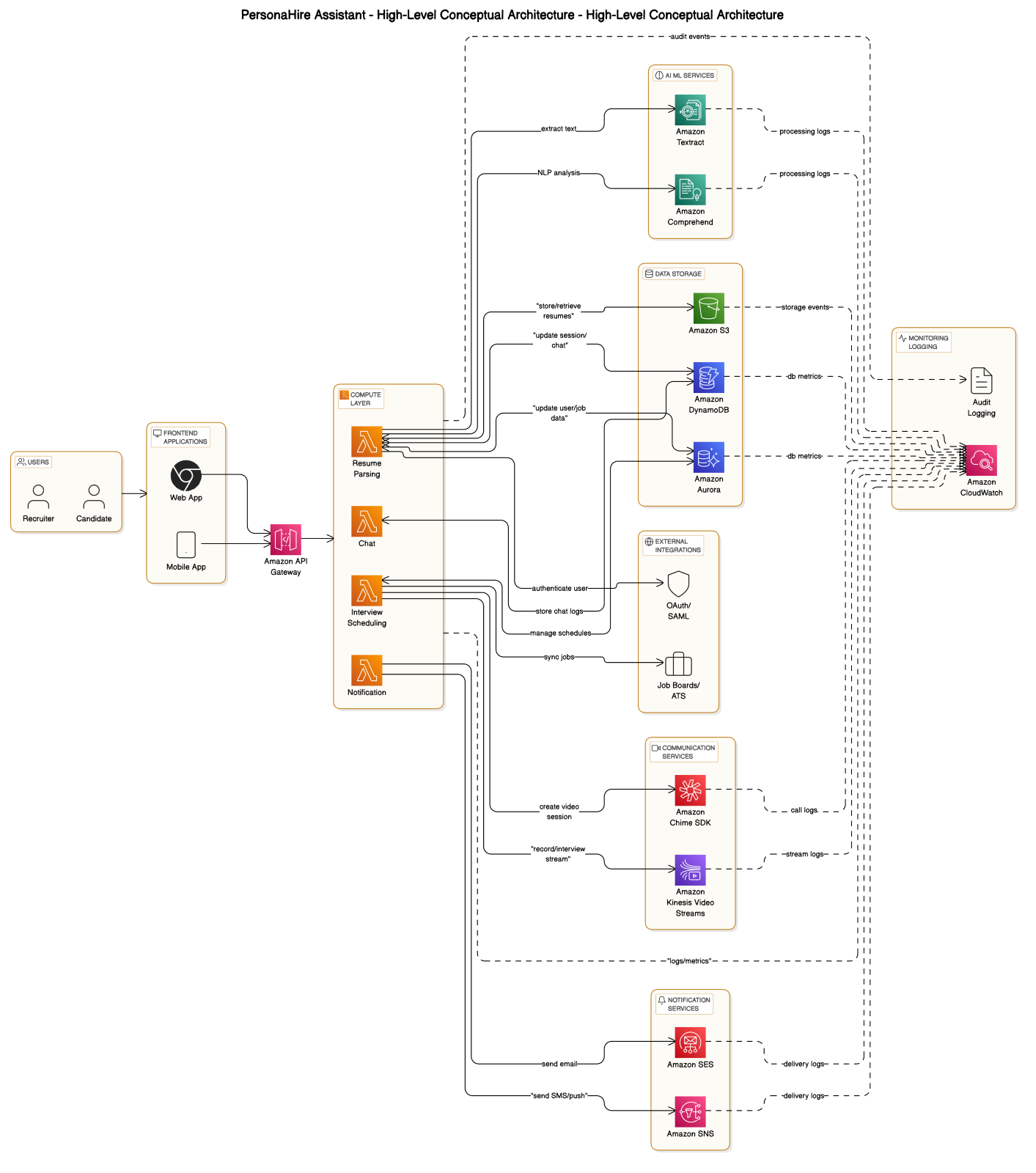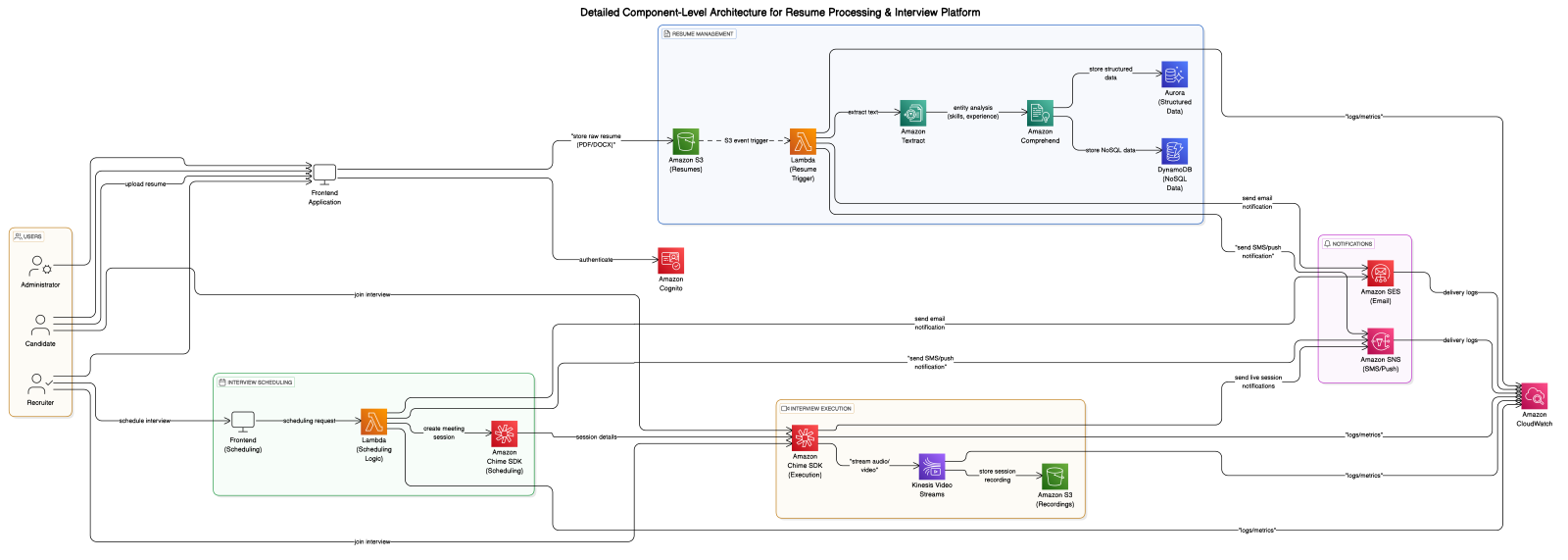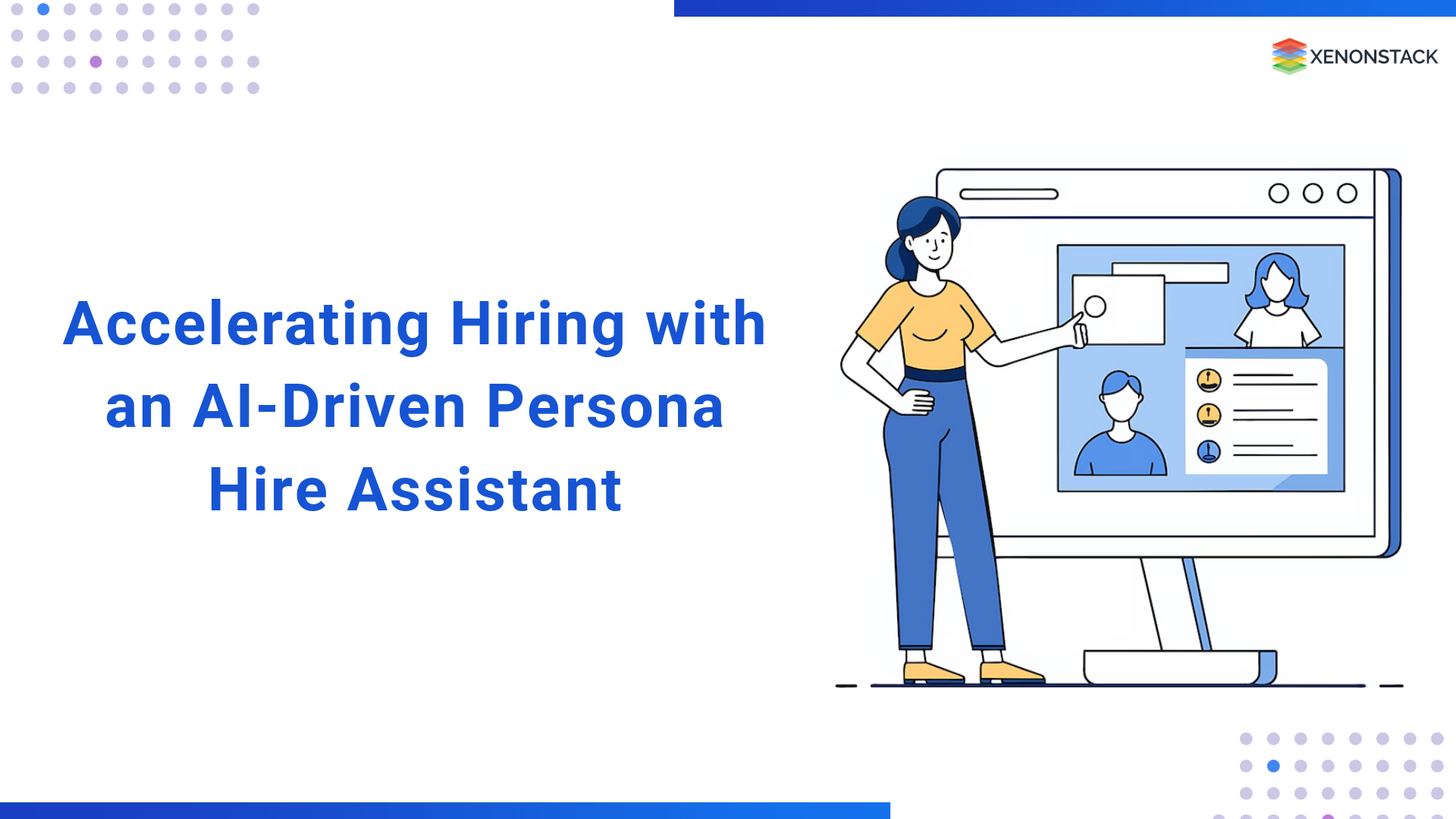The client, a mid-size recruiting firm, faces increasing competition and slow time-to-hire due to manual candidate screening and a fragmented HR platform. To address this, the company partnered with AWS and implemented Personal Hire Assistant, an AI-driven recruiting solution built on AWS services.
Personal Hire Assistant uses natural language understanding and machine learning to automate resume analysis, match candidates to open positions, and engage applicants through an intelligent chatbot. By leveraging the scalability and security of AWS, the company significantly accelerated its hiring process. The new system reduced average time-to-fill by 50%, lowered recruitment costs by 30%, and improved candidate satisfaction. Recruiters also achieved faster candidate sourcing and higher offer acceptance rates, enabling the company to place talent more efficiently and expand into new markets.
Customer Challenge
The company is a mid-sized staffing firm based in Seattle, with around 200 employees and serving clients across multiple industries. The company's core mission is to match qualified candidates to open positions efficiently and effectively. However, the existing recruiting process was highly manual, with recruiters spending hours reading resumes, conducting preliminary screenings, and managing candidate communication. The company relied on a legacy applicant tracking system that lacked search or reporting features. This manual, paper-heavy approach resulted in slow time-to-fill, risk of human error, and inconsistent candidate experiences. Candidates began dropping off in the process, and the company knew it needed a more efficient, automated solution to stay competitive.
Customer Information
Business Challenges
Company recruiting teams were overwhelmed by manual tasks. Recruiters spent significant hours reviewing resumes and conducting initial screenings, one candidate at a time. As a result, each vacancy required weeks of work to fill, and critical positions remained open far longer than desired, directly impacting client satisfaction. This made it difficult for the company to scale its services or respond quickly when clients needed talent, especially during peak hiring seasons.
Without automation, pipeline visibility was poor. Managers could not track how many candidates were in each stage, making it hard to forecast hiring needs or identify bottlenecks. The legacy applicant tracking system provided limited reporting, so Customer often relied on spreadsheets for candidate information. This impeded planning and prevented data-driven recruiting decisions.
Technical Challenges
Company's existing infrastructure was outdated. The legacy applicant tracking system ran on local servers and offered no API for integrating new tools. Data was siloed: resumes, job descriptions, and candidate communications were stored in separate spreadsheets and email systems. This fragmentation made it difficult to build a comprehensive candidate profile and apply analytics. Additionally, the volume of unstructured data—thousands of resumes and social profiles—posed a processing challenge. The team had no built-in machine learning platform to analyze text or extract insights automatically.
Another challenge was integrating with other systems. The customer needed the new solution to work with its existing HR and payroll software without disrupting operations. Data security and compliance were also critical: candidate records contained sensitive personal information, and Customer had to comply with regulations like GDPR. The company required a scalable, serverless architecture that could handle peaks in data volume without downtime. Designing and scaling an AI/ML solution was new territory for, requiring strong architectural guidance and automation to ensure reliability.
Partner Solution
To tackle these challenges, Customer engaged an AWS partner to deploy Personal Hire Assistant, an AI-driven recruiting platform. The partner brought deep expertise in cloud architecture and AI, designing Personal Hire Assistant as a comprehensive solution built on AWS. They integrated multiple AWS AI and data services into a cohesive workflow. Acme’s team collaborated closely with the partner during solution design and testing. This engagement followed AWS Well-Architected Framework principles to ensure a scalable, secure, and cost-efficient solution.
Solution Overview
Personal Hire Assistant is an end-to-end recruiting platform built on AWS. All candidate resumes, job postings, and related documents are stored in Amazon S3. When a new resume is uploaded, an AWS Lambda function invokes Amazon Textract to extract textual information. The extracted text is then analyzed with Amazon Comprehend to identify key skills, experience levels, and sentiment. Parsed candidate data is stored in Amazon Dynamodb, enabling fast queries. Machine learning models hosted in Amazon SageMaker analyse and score candidate-job matches, enabling personalised recommendations. Recruiters access these insights via a secure web application. The solution provides a serverless API through Amazon API Gateway and AWS Lambda. Acme’s existing applicant tracking system is integrated via REST APIs, allowing seamless data exchange between systems.
AWS Services Used
Architecture Diagram

Figure 1: High-Level Architecture Diagram

Figure 2: Component-Level Architecture Diagram
Implementation Details
The implementation followed an agile, DevOps approach. Work was organized into two-week sprints with cross-functional teams of developers, data scientists, and Customer stakeholders. Infrastructure was defined and deployed using AWS CloudFormation templates, enabling reproducible environments and version control of the entire stack. The partner automated the deployment pipeline using AWS CodePipeline and AWS CodeDeploy, which built, tested, and deployed code to development, staging, and production environments. This continuous delivery model allowed frequent releases and rapid feedback. Every AWS service was configured with security best practices from the outset, including least-privilege IAM roles and AWS KMS-managed encryption for sensitive data.
Migrating Acme’s historical recruiting data was an early task. Existing resumes and candidate records were exported from the legacy ATS and bulk-uploaded to Amazon S3. Serverless AWS Lambda functions were used to extract and transform this data, populating Amazon DynamoDB with structured profiles. The team-built REST APIs with Amazon API Gateway and Lambda to synchronize data between Personal Hire Assistant and Acme’s HR systems. AWS KMS-managed keys secured all data at rest.
Innovation and Best Practices
The solution design closely followed AWS best practices. The architecture was built on a serverless, event-driven model that ensures reliable and efficient operation with minimal operational overhead. Each AWS service was configured with recommended security settings: for example, all data is encrypted at rest with AWS KMS and IAM roles are scoped to the principle of least privilege. The partner applied the AWS Well-Architected Framework throughout, optimising for security, reliability, and cost.
Innovative features include the use of Amazon SageMaker to continuously update machine learning models as new data arrives, enabling AI-driven candidate matching that improves over time. The Amazon Lex chatbot provides a conversational interface for candidate interactions, streamlining scheduling and FAQs.
Results and Benefits
The customer realized significant improvements in both business metrics and technical performance. By automating recruiting tasks and leveraging AI-driven analytics, the company achieved faster hiring, cost savings, and more efficient operations. The following sections detail the key business outcomes and technical benefits.
Business Outcomes and Success Metrics
The new solution delivered measurable improvements to Acme’s recruiting operations. Within three months of deployment, the average time-to-fill dropped from 40 days to 20 days — a 50% reduction. Recruiter throughput doubled: each recruiter processed about twice as many candidates per month as before, thanks to automated resume screening and intelligent candidate matching. Recruitment costs fell by roughly 30% due to efficiency gains, while offer acceptance rates improved by 20%.
These outcomes translated into clear business value. Customer exceeded its hiring targets for the year, doubling its placement volume and boosting revenue by about 25%. The solution allowed the company to serve more clients without increasing headcount. Candidate satisfaction also improved: survey feedback indicated applicants felt more engaged and informed. Recruiters reported that they could focus on high-touch tasks instead of manual screening. All these factors delivered a strong return on investment: Customer expects to recoup the project costs in under 12 months, thanks to efficiency gains and higher placement revenues.
The Personal Hire Assistant platform runs on a highly scalable, serverless architecture. It automatically handles workload spikes – for example, the system processed over 10,000 resumes in the first quarter without manual scaling and maintained 99.9% uptime. All critical services operate across multiple Availability Zones for fault tolerance. Using managed AWS services eliminated the operational overhead of provisioning and patching servers, significantly reducing technical debt. Deployments became much faster: what used to take weeks can now be done in hours via the CI/CD pipeline.
Sensitive data is encrypted at rest and in transit, improving the security posture. Compared to the legacy on-premises system, these improvements have strengthened performance, reliability, and cost efficiency. The serverless model and modular design also improve developer velocity: new features and updates can be tested and deployed rapidly. The AWS-based solution delivers robust performance, high availability, stronger security, and easier maintenance than Acme’s previous environment.

.webp?width=1921&height=622&name=usecase-banner%20(1).webp)





